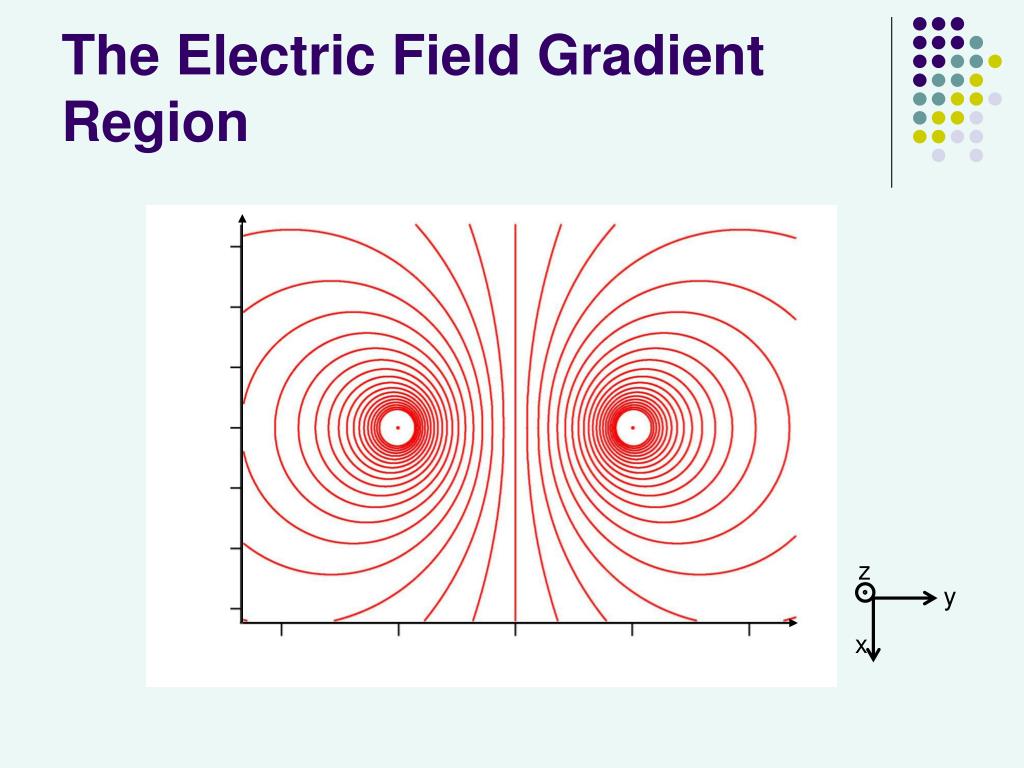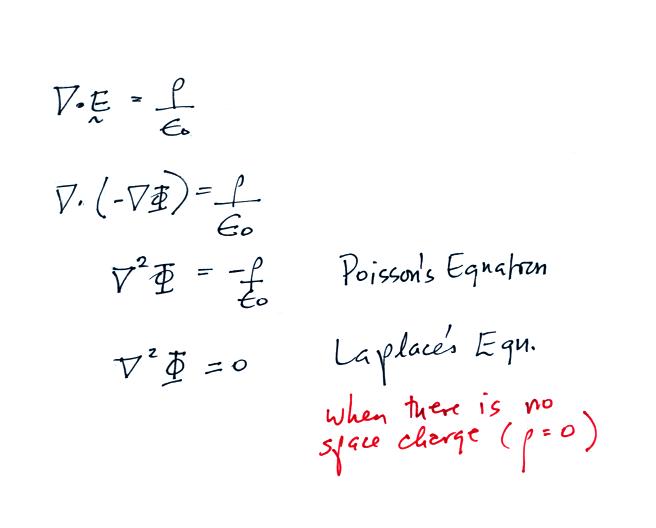a) Electric field gradient distribution at the tip region under DC bias
Electric Field as Gradient. The expression of electric field in terms of voltage can be expressed in the vector form . This collection of partial derivatives is called the gradient, and is represented by the symbol ∇ .The electric field can then be written. Expressions of the gradient in other coordinate systems are often convenient for taking advantage of the symmetry of a given physical.

Calculating E from V(x,y,z) E = potential gradient Electrostatic
See the text for details.) The work done by the electric field in Figure 19.2.1 19.2. 1 to move a positive charge q q from A, the positive plate, higher potential, to B, the negative plate, lower potential, is. W = −ΔPE = −qΔV (19.2.1) (19.2.1) W = − Δ P E = − q Δ V. The potential difference between points A and B is.

Electric field gradient squared distribution on the surfaces of both
An electric field gradient is a measure of how the electric field changes with respect to position within a region of space. It is a vector quantity that describes the rate of change of the electric field in each direction.
The simulation result of the electrical field and potential
5.14: Electric Field as the Gradient of Potential. where E(r) E ( r) is the electric field intensity at each point r r along C C. In Section 5.12, we defined the scalar electric potential field V(r) V ( r) as the electric potential difference at r r relative to a datum at infinity. In this section, we address the "inverse problem.
a) 2D plot of norm of electric field gradient b) Norm of electric field
The electric field is said to be the gradient (as in grade or slope) of the electric potential. For continually changing potentials, Δ V Δ V and Δ s Δ s become infinitesimals and differential calculus must be employed to determine the electric field.

Relation Between Potential Gradient And Electric Field YouTube
7.14. With this notation, we can calculate the electric field from the potential with. E→ = −∇ V, E → = − ∇ → V, 7.15. a process we call calculating the gradient of the potential. If we have a system with either cylindrical or spherical symmetry, we only need to use the del operator in the appropriate coordinates: Cylindrical:∇.

PPT Measuring Polarizability with an Atom Interferometer PowerPoint
Electric Field as the Gradient of Potential In Section 5.8, it was determined that the electrical potential difference measured over a path is given by (5.14.1) where is the electric field intensity at each point along . In Section 5.12, we defined the scalar electric potential field as the electric potential difference at

Lecture 4 Review of electrostatics pt. 2
In physics, chemistry and biology, a potential gradient is the local rate of change of the potential with respect to displacement, i.e. spatial derivative, or gradient. This quantity frequently occurs in equations of physical processes because it leads to some form of flux . Definition One dimension

Electric Potential Electric Field as Potential Gradient
As shown in Figure 7.5.1, if we treat the distance Δs as very small so that the electric field is essentially constant over it, we find that. Es = − dV ds. Therefore, the electric field components in the Cartesian directions are given by. Ex = − ∂V ∂x, Ey = − ∂V ∂y, Ez = − ∂V ∂z. This allows us to define the "grad" or.

Simulation of electric field gradient squared for cylindrical IDE
A numerical model of oil-solid multi-gradient filtration with electric field enhancement was developed by coupling the electric field governing equation, flow field governing equations, discrete phase tracking equation, and particle-wall collision model equation.. When the electric field strength is 2 kV/mm, the inlet flow rate is 0.3 m.

Contour plot of gradient of squared electric field strength, ∇E 2 rms
Droplet directional transport is one of the central topics in microfluidics and lab-on-a-chip applications. Selective transport of diverse droplets, particularly in another liquid phase environment with controlled directions, is still challenging. In this work, we propose an electric-field gradient-driven droplet directional transport platform facilitated by a robust lubricant surface. On the.

Electric Field as Potential Gradient FSc Class 12 PHYSICS Chapter
Relation between field & potential Calculating E from V (x,y,z): E = - potential gradient Google Classroom About Transcript Let's calculate the electric field vector by calculating the negative potential gradient. We first calculate individually calculate the x,y,z component of the field by partially differentiating the potential function.

Activating function (AF, gradient of the electric field) of the
The gradient of a scalar field is a vector that points in the direction in which the field is most rapidly increasing, with the scalar part equal to the rate of change. A particularly important application of the gradient is that it relates the electric field intensity \({\bf E}({\bf r})\) to the electric potential field \(V({\bf r})\).

Electric field intensity as negative potential gradient YouTube
In atomic, molecular, and solid-state physics, the electric field gradient ( EFG) measures the rate of change of the electric field at an atomic nucleus generated by the electronic charge distribution and the other nuclei.

Electric Field as potential gradient Class 12 ElectrostaticsNCERT
Electric fields are caused by electric charges, described by Gauss's law, and time varying magnetic fields, described by Faraday's law of induction. Together, these laws are enough to define the behavior of the electric field. However. is the gradient of the electric potential and.

(a) Electric field gradient distribution (V/m), (b) 3D top view of the
Measurement(s) electric field gradient Technology Type(s) computational modeling technique Factor Type(s) material studied Machine-accessible metadata file describing the reported data: https.